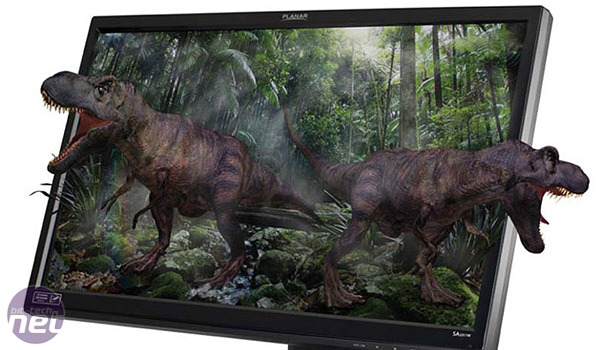Investigating 3D Screens
May 26, 2011 | 20:28
Companies: #acer #alienware #amd #bit-tech #dell #eizo #nvidia #viewsonic

3D Screen Design
If we’re locked into using TN panels for the immediate future, we were curious to find out whether screen makers tweaked their designs when including 3D technology. After all, most people have settled on the idea that the mandatory 3D glasses result in the 30 per cent loss in colour fidelity. This figure may only apply to passive glasses, as active glasses are less tinted when ‘open’, but there’s still a loss of brightness with shutter glasses. Do screen manufacturers recognise this, and do they do anything to compensate?Rob Musson of Eizo was dismissive of our concerns, saying ‘Not really because the glasses don’t block so much light so it can be compensated by turning up the brightness.’ BenQ was equally as unperturbed, ‘No, our customer is satisfied with the shutter glass solution so there is no plan to change the design of [the] monitor,’ Meanwhile, BenQ is more concerned about power draw, saying, ‘Users can adapt the brightness accordingly, factory settings are applied to reduce power by 50 per cent versus standard 3D products.’
ViewSonic conceded our point about reduced colour fidelity to some extent, however: ‘This has to be considered – but its more the engine and the response rates, quality of the panel, rather than anything else. All the components needs be a higher grade generally but the panel and the circuit engine are the focus. This is what ViewSonic specialise in, making the sum of the parts greater than the whole.’
It was Sascha Guenther of Dell that agreed most with our concerns about loss of colour and brightness, though. When talking about why TN technology has been used in all the 3D screens we’ve seen he said that, ‘Considering that due to the reduced brightness with 3D glasses, colour reproduction is not 100% accurate, a main selling point of IPS panels won’t have as much of an effect as in 2D.’
When asked whether Dell made any design tweaks in light of this thinking he told us, ‘That is what we have done with our Alienware brand of 3D monitors, bringing [the backlight brightness] up to 400 cd/m² for the 23in version. But of course there is always room for further improvement and that’s what our engineers are working on right now.’
Ooo, tell us more about that work we asked, only to receive the usual rebuff from a manufacturer plotting future developments. ‘The 3D market is an interesting area right now and I don’t want to speculate what the future will bring and can’t comment on upcoming and/or unannounced products.’ However, Guenther did tell us that while the Alienware range of screens was focused on 3D support and the UltraSharp range on colour accuracy, ‘We are working on bringing all this together in one device but that day has not come just yet.’
BenQ was a bit more open about its future plans, with Posen Wang telling us that we are already working on a “bare-eye” 3D monitor (Lenticular) that will not require shutter glasses which we will look to bring out in 2012’ Leticular technology, similar to the parallax barrier screen used in the Nintendo 3DS, might not require glasses, but it is restricted to zones of optimal viewing – lean outside of those zones and all you’ll see is a blur. It’ll be interesting to see how generous those zones are in BenQ’s implementation.
Less frivolous was Eizo’s response to what it’ll be up to next. Essentially it’ll see what the market demands, but Rob Musson reminded us that it had already released 3D technology in the form of the RadiForce GS521-ST for mammography viewing. While we’re all mucking about playing games on 120Hz screens, it seems 3D can be a useful tool for doctors; if so then 3D can be deemed a successful technology for mankind as a whole.

MSI MPG Velox 100R Chassis Review
October 14 2021 | 15:04










Want to comment? Please log in.